What Is the PESO Model?
To learn the fundamentals of the PESO model, download PRSA’s new “An Introduction to the PESO Model” Thought Leadership Report, by Gini Dietrich. https://www.prsa.org/peso_booklet/
Gini Dietrich
The PESO model officially launched in 2014, when Spin Sucks (the book) was published.For several years before that, it was the process used in my agency—Arment Dietrich. But it wasn't as complete as it was when I published the book.But then, I read Traction: Get a Grip on Your Business in early 2013—and learned how important it is for a service business to have a process. And, for branding purposes, to also have a name to go along with it.As we began to outline the process we used for clients and think about a name, I read Built to Sell. And that solidified the idea that we had to get it on paper—once and for all—and use it to discuss our process with clients.Enter the PESO model.We finally had something that was easy for clients to understand—and for us to use in training new colleagues. At the same time we were communicating it externally, we began to build the vision for Spin Sucks (to change the perception people have of the PR industry). That's when we realized what we were doing internally would be effective to the industry, as a whole.So I included it in the book, to teach communicators about the process and how to use it in their own programs.
What is the PESO Model?
The PESO model takes the four media types—paid, earned, shared and owned—and merges them together.
- Paid Media. Paid media, in this case, doesn’t refer to big, fancy commercials and highly creative print ads. On the contrary, paid media for a PR program is social media advertising, sponsored content, and email marketing. Think Facebook ads, LinkedIn video ads (in beta now!), and Outbrain for content amplification.
- Earned Media. Earned media is what you know as either publicity or media relations. It’s getting your name in print. Having a newspaper or trade publication write about you. Appearing on the noon news to talk about your product. It’s what the PR industry is typically known for, because it’s one of the few tangible things we do.
- Shared Media. Shared media is also known as social media. It’s evolving as well, and continues to build beyond just marketing or customer service teams using it. Organizations have begun to use it as their main source of communications internally and externally. This is curated content and Facebook Live. It's putting the social back in social media by creating engagement and community.
- Owned Media. Owned media is otherwise known as content. It is something you own, and it lives on your website or blog. You control the messaging and tell the story in a way you want it told. This is not hosting your content on Medium or Facebook Notes. It's owning your content and the platform it lives on.
When you integrate the four media types, you may find you also have influencer engagement, partnerships, and incentive programs that extend beyond your internal walls. And when the PESO model is working at its best, it can help you establish authority.Authority means you’re a thought leader. Others see you as an expert … even your competitors. And Google links to you on the first page of results because it also sees you as an expert.If you have enough authority that both Google and your competitors see you as the expert, you win the human and the SEO game.This is the golden ticket.
Why Not OESP?
As the industry began to take a hold of this process, communicators began to ask me, "Why PESO? What we do never starts with paid."I agree! If I were to order the media types in order of importance, from a communications perspective, it would be OESP—owned, earned, shared, and then paid.But that's a lot harder to remember, isn't it? And what's the number one rule of branding? Create something memorable. (OK, that may not be the number one rule, but it's pretty darn close.)PESO is a lot easier to remember and it also proves that what we do is integrated and measurable. It helps us extend beyond media relations and crisis communications and event marketing and reputation management. It puts us in step with our marketing brethren and it lands us a valuable seat at the executive table.
Where Can I Learn More?
Download PRSA’s new “An Introduction to the PESO Model” Thought Leadership Report to learn more about:
- Why communicators should embrace the PESO model
- How to use paid media in your communications programs and what to measure
- How to integrate earned media so it's measurable and leads to organizational goals
- What to include in shared media and what to measure
- How owned media builds authority and thought leadership—and what to measure
- Metrics, a dashboard, and providing results to the executive team
Gini Dietrich is the founder and CEO of Arment Dietrich, an integrated marketing communications firm. She is the author of Spin Sucks, co-author of Marketing in the Round, and co-host of Inside PR. She also is the lead blogger at Spin Sucks and is the founder of Spin Sucks Pro.


